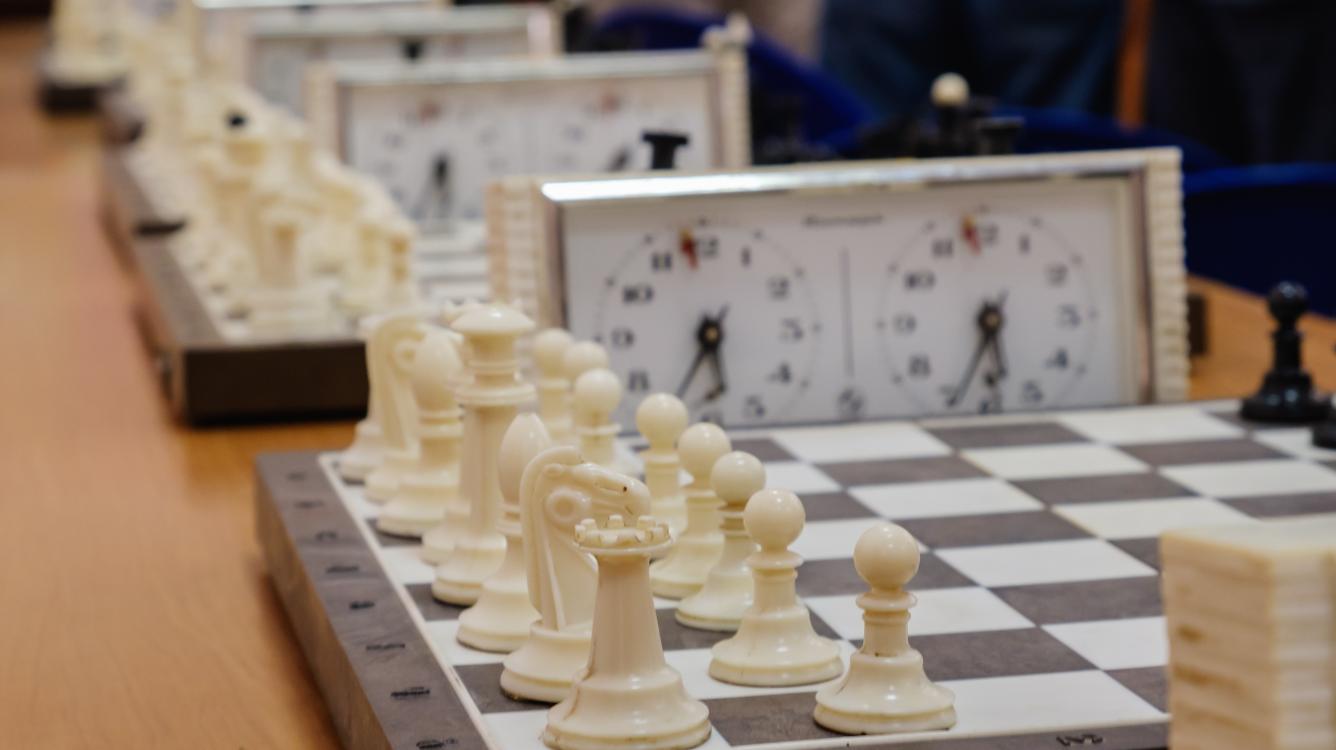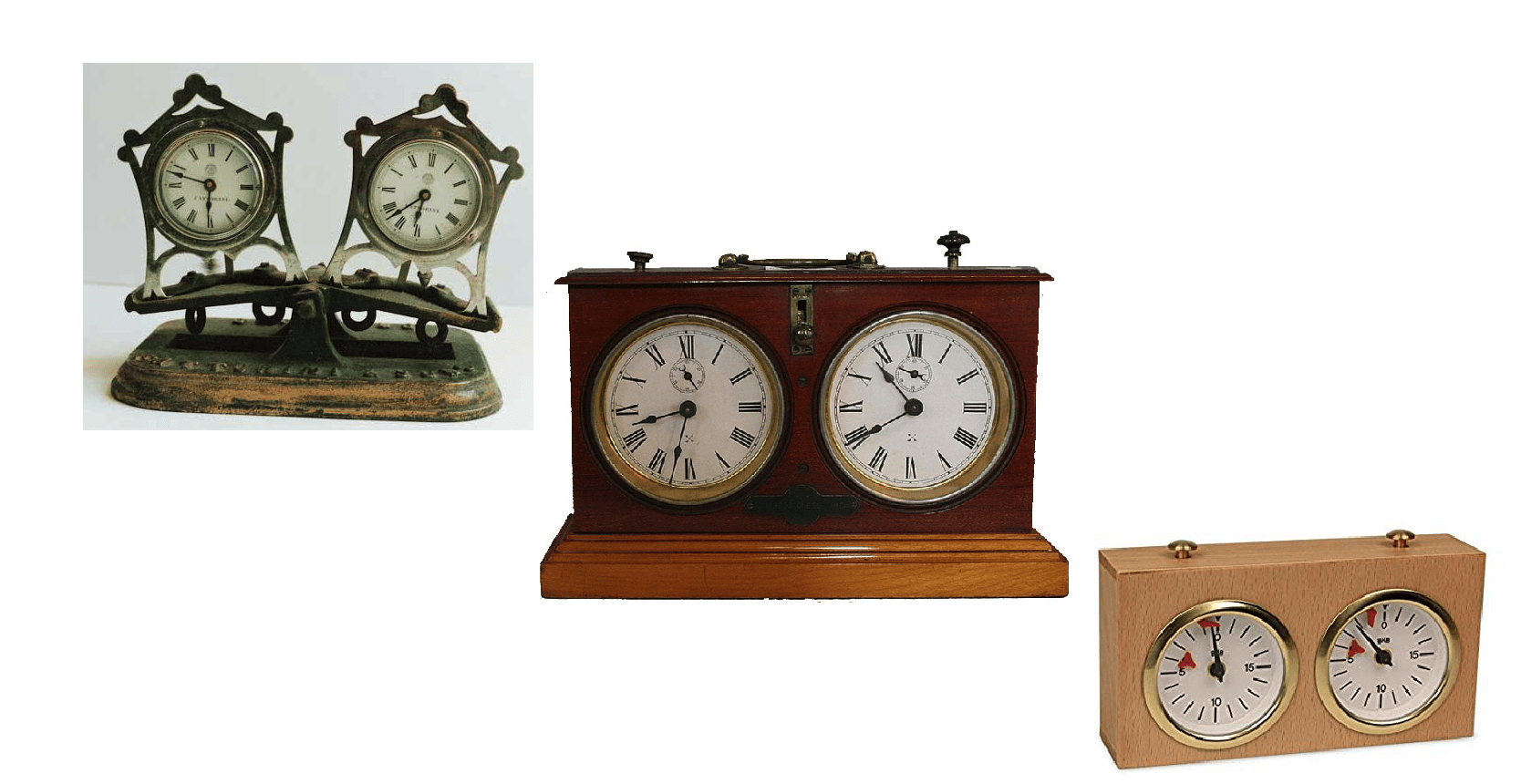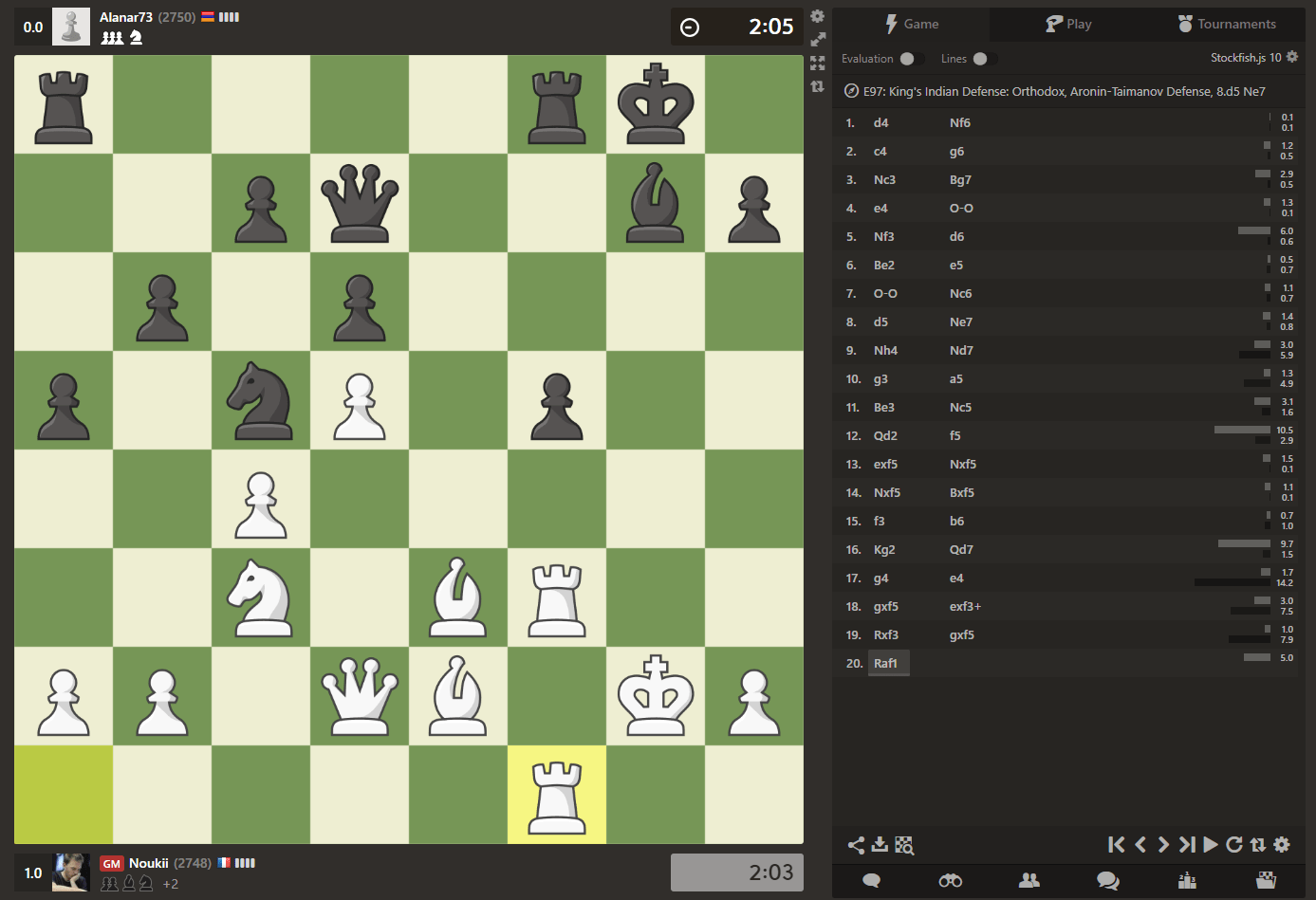
Chess Clocks: An Introduction
In the early 1800s, competitive chess was a time commitment, with games lasting 8-10 hours. Players would often try to stall and exhaust each other. One infamous match between Howard Staunton and Pierre St. Amant in 1843 reportedly took over 14 hours!
In the 1850s, event organizers started to innovate to reduce game times to something more friendly for players and fans. Initially, watches and sand-timers were used. And at first, players didn't lose if they timed—they had to pay a fine!
By the 1880s, mechanical chess clocks began to appear, foreshadowing the familiar two-faced analog clocks of the 20th century.
Chess clocks are set at the start of the game to count down from the agreed time. Just one of the two clocks runs at a time, with players starting their opponent's clock (and pausing their own) by pressing a button after making each move. Many models of 20th-century clocks featured a small flag on the clock face that would fall to clearly indicate when a player's time was up. And by then, running out of time usually meant forfeiting the game!

The invention of the chess clock saved classical chess, making 10-hour matches a thing of the past. But chess clocks didn't change much until the 1970s, when the first digital chess clock was invented by a student at Cornell University. And that changed everything once again.
Not only were digital clocks more accurate than analog ones; they could also be programmed, adding scope for creativity and new ways to time games. Most famous was the clock patented by Bobby Fischer in 1988, which added a small amount of bonus time to each player's clock for every move. This meant that while time remained a big factor, a player in a clearly winning position wouldn't lose just because they didn't have time to physically make the needed moves. Fischer's bonus time has since become a common setting at chess events around the world, as well as in the world of online chess. It is often called increment today.
Digital chess clocks had one other important impact: making it practical to play full games of chess with much shorter time controls than ever before. While the sand timers of the 1800s brought game times down to a few hours, digital clocks enabled players to play entire games in a couple of minutes, and created a groundswell of popularity for "speed chess" time controls, like blitz or bullet, which dominate the online chess scene today.
Let's take a closer look at how time controls work in general, and on Chess.com.
- What is a "time control"?
- Bullet
- Blitz
- Rapid
- Daily
- Online Chess
- Clock Issues
- Live Chess Timing Rules
What is a "time control"?
It's how much time a player has to make all the moves in a game. Some time controls are more complicated, and often break the game into stages. For instance, players might have two hours to play the first 40 moves of a game, then another hour to finish the game, all while getting 30 seconds of bonus time for each move they make. (Yes, most modern digital clocks can handle all of that easily!)

Fortunately, most time controls for casual or online games are much simpler than that, consisting of a base time and an optional increment of bonus time to be added per move. This is usually written as [base time] | [increment]. For instance, a five-minute blitz game with no bonus would be 5|0, and a three-minute game with a two-second bonus would be 3|2.
Please note that base time is for the entire game, per player. In a 5|0 game, the white and black clock each gets five minutes, meaning that the game could take up to 10 minutes in total.
The time control is also what determines the type of game it is: bullet, blitz, or rapid.
Bullet
Bullet games are the fastest! We define bullet games as those where each player gets less than three minutes total time in a 40-move game. The "40 moves" part is important only when the time control includes a bonus increment. For example, 2|1 qualifies as a bullet time control because it gives players just two minutes and 40 seconds (40 x one-second increment) to think in a 40-move game.
Blitz
Blitz time controls give each player between three and 10 minutes total time in a 40-move game.
Rapid
Rapid games include all live games where players have more than 10 minutes to think in a 40-move game.
Daily
And then there are daily games, which have an entirely different time control. Daily chess time controls are per move, meaning there is no base time for the whole game here, you simply get a certain number of days for each and every move. This is equivalent to an all-increment time control.
Online Chess
The advent of online chess allowed players thousands of miles apart to play bullet chess, and has required some new developments in the evolution of the chess clock. As we saw with digital clocks, online chess spurred an acceleration of play: Moving with a mouse is much faster than moving physical pieces.
Some players pre-move online, not even waiting for their opponent to complete their turn before they make their own next move! And as for the clocks, you don't even have to hit a button anymore: Make your move and your opponent's clock starts instantly. The clocks take care of themselves now—and may even warn you with a sound effect or animation, when your time is low.

As wonderful as this is, a significant drawback of Internet speed-chess is the possibility of losing connection to the chess server during a game, which can cause some odd-looking behavior from the clock. In a sense, live online chess games have not one chess clock per player, but three:
1. Your clock that you see (on your local web browser or mobile app)
2. Your clock as your opponent sees it on his or her client
3. The true clock, on the server in the middle.
In a perfect world, those three clocks remain almost perfectly in sync throughout the game. However, that isn't always the case, given that each chess move travels across thousands of miles of wires before arriving on the server.
Clock Issues
Clock Issue 1: Network Lag
What's actually happening: The server can detect when one or both players in a game are suffering from network lag, which can be defined as a delay between a player receiving or making a move in his or her game and the server sending or receiving that move. In such cases, the server will forgive up to one full second to help compensate that player for time lost.
What it looks like: Your opponent's clock seems to pause for a second or two while counting down.
Issue 2: Disconnection
What's actually happening: For example, the white player makes a move in a blitz game. The white player disconnects. The black player moves one second after white's disconnection. White reconnects 10 seconds later and the board and clocks are synchronized again with the server.
What it looks like: White moves. Black's clock starts as usual, and counts down for 10-11 seconds. Suddenly, it's White's move again, but Black's clock also jumps up 8-9 seconds, and White's down by the same! In a more extreme example, White could time out and forfeit the game, all while waiting for Black to move (as far as they know).
So what to do? On the server, Chess.com continues trying to connect to the player to reconnect as quickly as possible. There are also a few things you can do yourself to minimize issues.
Here are a few tips that should help you maintain an accurate chess clock and connection:
∙ Use time controls that have an increment (bonus time per move) if you aren't in the mood for a mad scramble of desperate moves at the end, or if you just hate the idea of losing on the clock when you're winning on the board.
∙ Use time controls with NO increment if it's all about quick thinking, lightning reflexes, and the element of surprise! Time scrambles are fun!
∙ Use a strong and steady internet connection. Even very short disconnections that might go unnoticed in other applications can have a big impact on a bullet game. Conversely, if you know your connection is a bit shaky, you might want to try a more forgiving time control. Check your wifi and router to make sure they are up to date and working properly!
∙ Adjust your Live Chess connection settings. If you are consistently having problems, check out how to customize your connection settings to a configuration that might work better for you!
Some Rules of Timing
As in the early days of chess clocks, Chess.com has had to come up with a few innovations to keep certain Live Chess games from wasting our members' time...
- At Chess.com, a Live game will be automatically Aborted (generally with no result) if either player fails to make their first move in...
- 15 seconds (Bullet)
- 20 seconds (Blitz)
- 60 seconds (Rapid -- as well as all variants, and all games where at least one player is titled)
- Games will be automatically Abandoned (Lost) if a player disconnects for 10% of the estimated total clock time (or at least 30 seconds). Again, imagine 40 moves if there is an increment!
A 5|5 game would therefore be...
300 seconds + (5 seconds x 40 moves) =
500 seconds (estimated total)
Ten percent of 500 is 50 seconds: the maximum time a player may be disconnected before abandoning (and thus losing) a game with a 5|5 time control. (Time controls of 5|0 and shorter allow for a disconnect of 30 seconds before the game is declared abandoned.)
- Arena games are declared Abandoned (Lost) if a player does not make a first move in 30 seconds.
- Finally, if a player appears idle on a single turn for half of their total base time (disregarding any increment - so, for example, 90 seconds in a 3|2 game) the server may once again declare the game Abandoned (Lost).
Sportsmanship Tip! Aborting games is for when life interrupts chess. It is not a good way to find a more worthy opponent, a chance to play as White, or a different opening! Players who abort games frequently end up getting paired differently - to protect those who don't - and that means longer waits, etc. You don't want that. Check out our Sportsmanship & Fair Play Policy to learn more about keeping your account in good health!
Well! Chess clocks have been a game changer for almost two centuries now, and their mark on the game has been immense! We hope you enjoyed this quick look at their history and maybe learned something interesting about how they work at Chess.com.
If you would like a free, full-featured chess clock for your offline games, we made one for iOS and one for Android that we hope will serve you well. Enjoy and thanks for reading!







